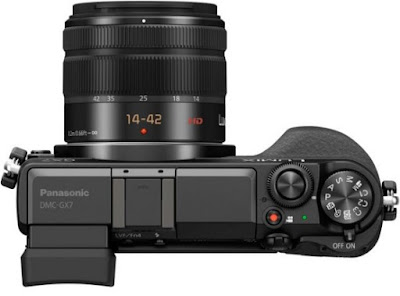Panasonic Lumix DMC-GX7 review release date
2016 new Panasonic Lumix DMC-GX7 review Panasonic has appreciated a straight keep running of five-star audits for its present line-up of minimal framework cameras (CSCs), yet the GX7 may very well be the best of the cluster. It replaces the Panasonic Lumix DMC-GX1 with a thin, rangefinder-style plan and aficionado agreeable controls. It's more costly than the GX1 was at dispatch, but on the other hand it's altogether better indicated.
The huge news is an incorporated tilting electronic viewfinder (EVF), which was just accessible as a costly and marginally lumbering extra unit for the GX1. Optical adjustment is incorporated with the sensor, so it'll work with any lens. The LCD touchscreen is more keen and tilts here and there. There are double summon dials for direct access to introduction settings, a committed auto/manual center switch and Wi-Fi with NFC for remote exchanges and remote control.
 |
| Panasonic Lumix DMC-GX7 review |
Panasonic Lumix DMC-GX7 review
It's additionally the most nice looking camera Panasonic has constructed in quite a while. It might not have the retro chic of Olympus Pen and Fujifilm X cameras, yet the magnesium compound body looks and feels like a genuine bit of pack - whether you choose the all-dark model or the retro-enlivened silver completion. The 14-42mm unit lens is a little bulkier than the GX1's mechanized zoom lens, yet it's still surprisingly little and an incredible fit on the GX7. In case you're in the wake of something slimmer, consider the eminent 20mm f/1.7 hotcake lens, which is accessible as the DMC-GX7CEB-S G unit.
Panasonic cameras have a tendency to be quick and instinctive to utilize, and this one is no exemption. Self-adjust was truly fast, at somewhere around 0.2 and 0.4 seconds from squeezing the screen to catching a photograph. We quantified 0.4 seconds between shots in ordinary use, and the 5.2fps persistent mode endured until the card was full. Opponents, for example, the Sony NEX-6 and Olympus OM-D E-M5 oversee closer the 9fps check however rapidly ease back to around 3fps. Selecting ceaseless and RAW saw execution tumble to 1fps after ten casings, yet that is still a respectable result.
Taking care of AND EVF
The controls are carefully laid out, with named catches for all the most imperative capacities and twin control dials for rapidly changing screen speed and gap. A Quick Menu utilizes the touchscreen to great impact to get to different capacities, and you can alter which controls the dials influence contingent upon the shooting mode. We like the new Highlight Shadow capacity, which permits complexity to be controlled by means of the double dials and a bend based realistic presentation.
 |
| Panasonic Lumix DMC-GX7 |
The touchscreen makes it simple to move the self-adjust point, whereupon the order dials control the extent of the dynamic zone. It's an incredible framework, however there is a little obstacle. At the point when the screen was calculated upwards for use at waist tallness, touching the screen set off the eye-level sensor, so the camera consequently changed from LCD to EVF. There's a menu alternative to diminish the affectability of this sensor yet it had no distinguishable effect. We in the long run got around it by touching the screen with a thumb instead of an index finger, which kept hands off the beaten path of the EVF. Contingent upon how you hold the camera you might experience this a great deal, yet we soon balanced our grasp to abstain from setting off the sensor.
The EVF itself is to a great degree noteworthy. Its 2.8-million-speck determination is the most astounding we've ever seen from a CSC, and it's huge – like the distinguishable size of a full-edge SLR's optical viewfinder. The tilting configuration is welcome yet we wouldn't say it's a noteworthy ergonomic achievement. Once the camera is at eye level, it's very little of a weakness to point your head toward the subject you're shooting. The eyecup that encompasses the EVF is deficient, and doesn't completely remove surrounding light. We found this entirely diverting when the sun was in simply the wrong place and shone in through the side of the EVF.
 |
| Panasonic Lumix DMC-GX7 |
Sensor-based optical adjustment is somewhat of an amazement considering that Panasonic routinely incorporates it with its lenses, including the 14-42mm unit lens we tried. Its prime lenses aren't settled, however, nor are good Olympus lenses, so it's an appreciated expansion. The camera offers need to lens-based adjustment on the off chance that it's accessible; trying with a Panasonic 20mm hotcake lens, we think we can see why. The sensor-based adjustment gave an appreciated change to the achievement rate of shots at 1/13s, however didn't seem to have much effect at quicker or slower screen speeds contrasted with tests with adjustment impaired. The unit lens' adjustment (at the same 20mm central length) gave vastly improved results, and just started to battle at 1/3s. It's difficult to make conclusive judgements about the unwavering quality of adjustment frameworks, yet taking into account our tests we wouldn't say this one merits getting amped up for - there's still recognizable shake when attempting to utilize an Olympus lens contrasted with Panasonic's balanced out lenses of the same central length
thx for reading :)
Comments
Post a Comment